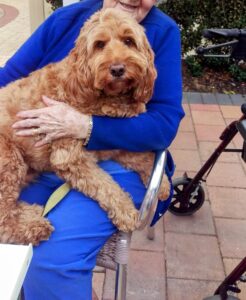
My dog George is a therapy dog. He is semi-retired now as he’s becoming an older gentleman, he turns 12 this May.
For many years George and I volunteered every weekend at a dementia facility, and he was also the therapy dog at the university where I worked. We would also visit schools, childcare centres and we also worked with Psychologists helping children and adults manage their dog fear/phobia.
His job was to make people feel happy and he enjoys every minute of the time he spends with people and folk are always so happy to see him. The dementia facility we visited was a “lockdown” facility. The patients there were deemed at risk and were generally the most serious cases. Going there was confronting and challenging, worthwhile and humbling.
The patients were so excited to see George. It would remind them of dogs they had in their earlier life, and it would trigger conversations around dogs and pets and general reminiscences. They could pet him, brush him and he would help calm them when they felt confused and/or agitated. It was a really beautiful way to engage with people who had limited options for engaging with the world. All up we spent around 6 years visiting.

In this photo, the lady asked if she could have him on her lap for a “real good” cuddle 🥰
Nowadays George only picks up the occasional (free – we never charge) gig as he’s older and needs more rest.
He has come into my current workplace for RUOK Day to spend time with team members and customers. He’s coming to work with me tomorrow for our Wellbeing Day, a day that I actually get to organise as part of my job! I literally have the best job! The whole team and the Managers are thrilled to be welcoming a four-footed, furry, loveable visitor.
Tonight, I’ll spend extra time brushing out his fur (he doesn’t shed much as he’s a Spoodle/Cockapoo – a Cocker Spaniel crossed with a poodle). But I want to make sure his fur is glossy and fully floofy for his visit.
Recently, we worked on a project visiting a dementia ward (different from the place where we volunteered) and spending time with a select group of patients. We would visit once/week and spend an hour to two hours with the patients.
The project is gathering data on whether the patient’s perceived quality of life improved or if they retained memory of the dog visits from week to week.
Research on animal assisted therapy for dementia and Alzheimer’s patients is growing and Dementia Support Australia Animal Assisted Engagement in Dementia Care outline the benefits of this type of care:
“Interacting with animals has many benefits for older people. It can have a positive impact on physical, social, emotional, motivational and cognitive functioning, while helping reduce mood disorders such as anxiety and depression. Animal assisted or pet engagement aims to provide pleasure and relaxation.”
A research study conducted in 2019 Effectiveness of the dog therapy for patients with dementia – a systematic review | BMC Psychiatry | Full Text (biomedcentral.com) found that animal assisted therapy can be a very beneficial and complementary treatment, particularly regarding behavioural and psychological symptoms, and that this is true for patients with varying degrees of dementia severity when that therapy is tailored to their unique needs and interests.
So there you have it. My dog is a sweet soul. He was born to be a therapy dog, I knew it from when he was a pup. Best. Dog. Ever!
What do you think?
You must be logged in to post a comment.